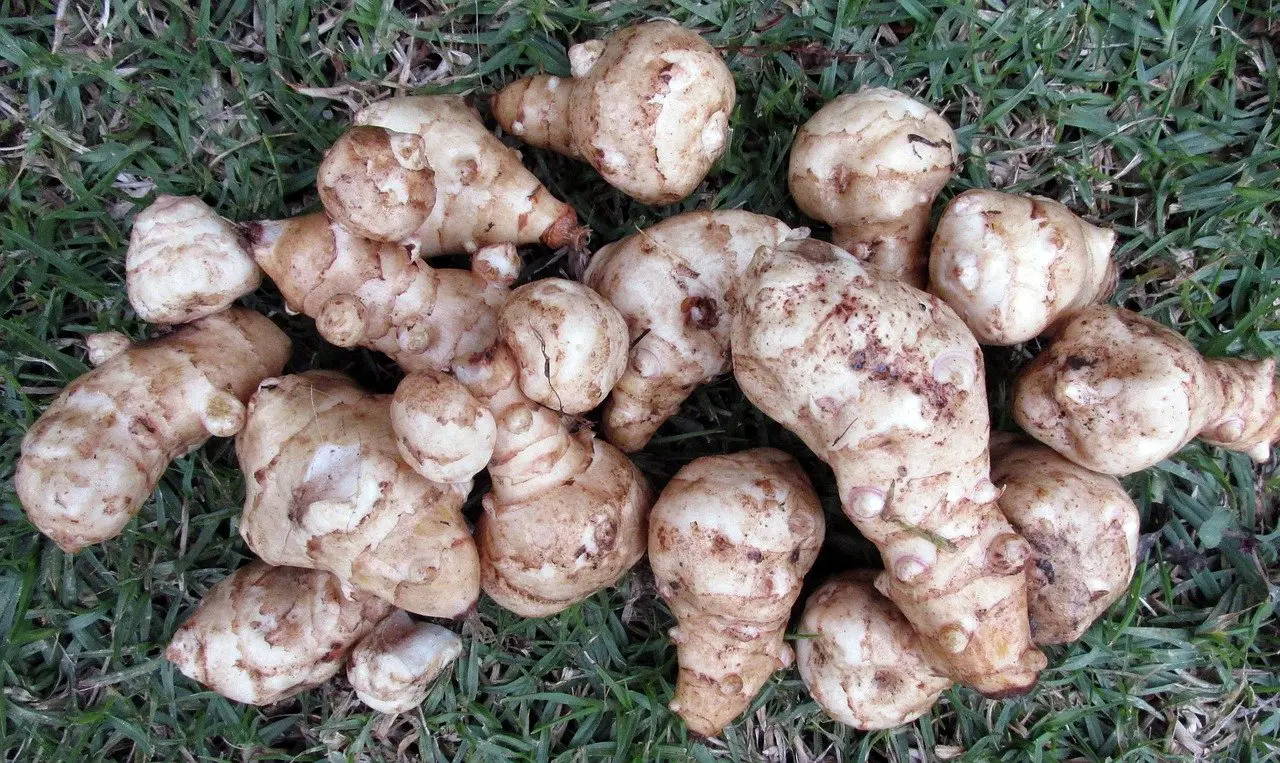Last Updated on April 12, 2024 by Real Men Sow
Jerusalem Artichoke tubers are tasty, available all winter, exceptionally easy to grow, completely undemanding, very low-maintenance, and ideal for beginners. It is a surprise that they’re not widely grown. The fruit is low in calories with just one drawback that will be discussed later.
What is a Jerusalem Artichoke Tuber?
The Jerusalem Artichoke (Helianthus tubrosus), a perennial sunflower that is native to North America. The tubers are edible raw or cooked and come in knobbly white or red-fleshed. They are more suited for cooler climates and will grow in Florida, given that the harvest will be less.
Often sold unnamed, it now has a wide variety of names. In the USA, the French Mammoth White produces large yields. In the UK, the Fuseau is less knobbly like the US Golden Nugget and American. The Dwarf sunray is more compact and produces more flowers, better suited for the flower bed. The tubers are also easier to peel.

How To Plant Jerusalem Artichoke Tubers
Tubers can grow in any type of soil, giving gardeners the opportunity to make use of the difficult part of their garden. However, grounds saturated with water for a long time just cannot be a place to grow your plants. Jerusalem Artichoke Tubers act like all vegetables where the richer the soil, the larger they will grow and be easier to cook once harvested. Improving poor soil is recommended, add lime to raise the pH to 6.5 due to the reason that tubers prefer alkaline conditions.
Their stems are sturdy and hollow, they grow tall enough to break the wind. Make sure to only plant many if you’ve chosen them for the purpose of breaking the wind. Planting five would be enough since one can produce twenty.
Planting them at 4-6 inches (10-15 cm) deep, 12-18 inches (30-45 cm) apart is recommended. Make sure the shoots are pointing upwards once they sprout. Be careful pointing them in the right direction since they are fragile and may break off easily. Plant tubers by cutting them into pieces, making sure each piece has a bud, and not letting them dry out.
Caring for Jerusalem Artichoke Tubers
It is best to water them and to earth the stalks as they grow. You will have a bigger harvest and larger tubers if this is done.
They can easily grow to ten feet tall, and overshadow other crops. Cut stalks to approximately 4 feet (120cms) in the middle of summer if this is possible. They will become bushier and more compact. This discourages flowering, which begins in autumn, and encourages them instead to focus their energy on growing larger tubers.
They provide late nourishment to insects and can be cut back. Instead of cutting them, you could use wires and canes to corral them so they don’t wiggle around on the bed.
Harvesting Jerusalem Artichokes
When the plants start to die back, or around late autumn November for northern hemispheres, you should begin harvesting. You can harvest in mid-winter if you live somewhere warmer.
Jerusalem artichokes can be difficult to store but they are very happy in their natural state of being left in the ground until needed. Mulch well if your ground freezes to extend the harvest time. Prevent them from shriveling by storing them in a cool place with high humidity.
Replanting Artichokes for the following harvest
If you have a permanent place for them to live, it unnecessary to remove them all. However, congestion will occur over time if you do not. In the spring, remove all the plants from the bed and then replant the largest, smoothest ones. This will ensure that your artichokes are less knobbly in the future.
You can get rid of them over some years if you are really sick of them by covering the area with weed control fabric.
How To Eat Jerusalem Artichoke Tubers
Jerusalem Artichokes are rich in Inulin, a carbohydrate that feed bacteria in your stomach. It’s not safe to consume them too much even if they’re low in calories. Wind is another side effect.
They make delicious soups when combined with sweet potatoes, carrots, or peppers. The artichokes are recommended to not make up more than half of the ingredients.
It’s hard to peel them due to their knobbly texture. Roasting them in their skins or boiling them for around 20 minutes until they’re tender would help you peel them easier.
You can also eat them raw or make salads from them. However, the flesh is a little like water-chestnuts and should be browned easily. After peeling the tubers, you should sprinkle with lemon juice or place in acidulated water until they are needed to preserve their whiteness.


